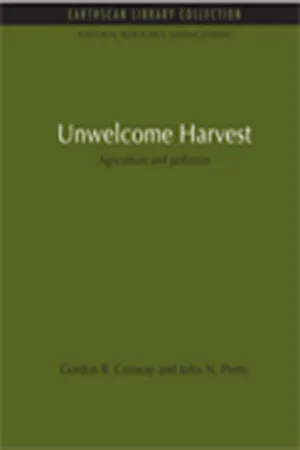
- 676 pages
- English
- ePUB (mobile friendly)
- Available on iOS & Android
About This Book
Agriculture Pollutes: pesticides can destroy wildlife and some are toxic to humans; some fungicides and herbicides cause cancer. Nitrates result in the contamination of drinking water and produce the risk of the blue-baby syndrome in infants and of stomach cancer in adults. Agriculture produces methane, ammonia, nitrous oxide and the products of burning off, all of which add to the world's problems of acid rain, depletion of the ozone layer and global warming.
This book, which focuses on the UK, the USA and Third World countries, is the first comprehensive review of agriculture and pollution: it examines the facts and assesses the relative dangers of each pollution problem. It also considers the effects of pollution on agriculture itself crop yields are depressed and livestock damaged by various forms of pollution from all sources.
The authors offer solutions to these apparently overwhelming problems, and describe existing technology which would allow us to deal with them.
Originally published in 1991
Frequently asked questions
| Contaminant or Pollutant | Consequences |
| Contamination of water | |
| Pesticides | Contamination of rainfall, surface and groundwater, causing harm to wildlife and exceeding standards for drinking water |
| Nitrates | Methaemoglobinaemia in infants; possible cause of cancers |
| Nitrates, phosphates | Algal growth and eutrophication, causing taste problems, surface water obstruction, fish kills, coral reef destruction; and illness due to algal toxins |
| Organic livestock wastes | Algal growth, plus deoxygenation of water and fish kills |
| Silage effluents | Deoxygenation of water and fish kills; nuisance |
| Processing wastes from plantation crops (rubber, oil palm) | Deoxygenation of water and fish kills; nuisance |
| Contamination of food and fodder | |
| Pesticides | Pesticide residues in foods |
| Nitrates | Increased nitrates in food; methaemoglobinaemia in livestock |
| Contamination of farm and natural environment | |
| Pesticides | Harm to humans; harm to humans; nuisance |
| Nitrates | Harm to plant communities |
| Ammonia from livestock and paddy fields | Disruption of plant communities; possible role in tree deaths |
| Metals from livestock wastes | Raised metal content in soils |
| Pathogens from livestock wastes | Harm to human and livestock health |
| Contamination of atmosphere | |
| Ammonia from livestock manures and paddy fields | Odour nuisance; plays role in acid rain production |
| Nitrous oxide from fertilizers | Plays role in ozone layer depletion and global climatic warming |
| Methane from livestock and paddy rice | Plays role in global climatic warming |
| Products of biomass burning (cereal straw, forests, savannas) | Enhances localized ozone pollution of troposphere; plays role in acid rain production, ozone layer depletion and global climatic warming; nuisance |
| Indoor contamination | |
| Ammonia, hydrogen sulphide from livestock wastes | Harm to farm worker and animal health Odour nuisance |
| Nitrogen dioxide from silage in silos | Harm to farm worker health |
Table of contents
- Cover
- Half Title
- Title
- Copyright
- Contents
- Glossary for Units of Measurement
- List of tables, boxes and figures
- Preface
- 1. Introduction to Agriculture and Pollution
- 2. Pesticides and the Environment
- 3. Pesticides and Human Health
- 4. Fertilizers and the Environment
- 5. Fertilizers and Health
- 6. Farm Wastes
- 7. Agriculture as a Global Polluter
- 8. The Impact of Air Pollution on Agriculture
- 9. The Impact of Land and Water Pollution on Agriculture
- 10. The Control of Pollution
- 11. Agriculture Without Pollution
- Index